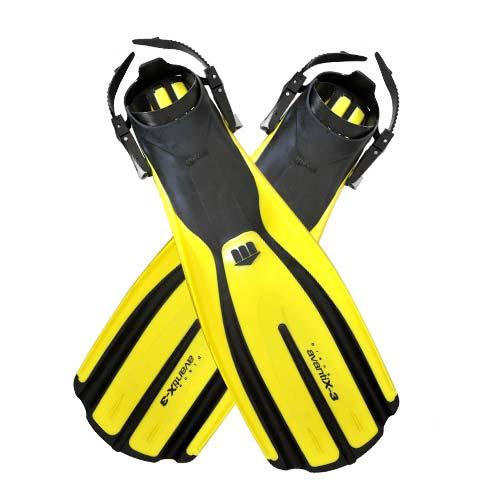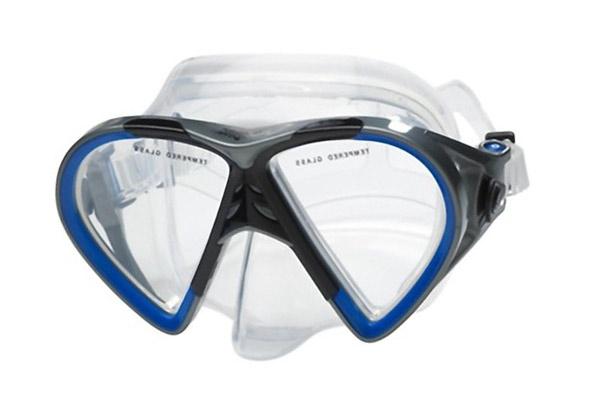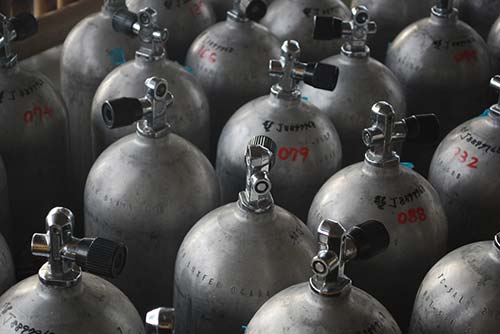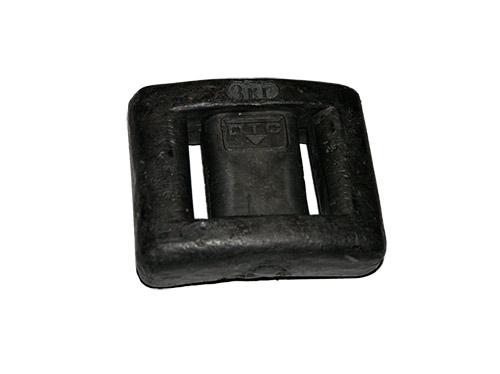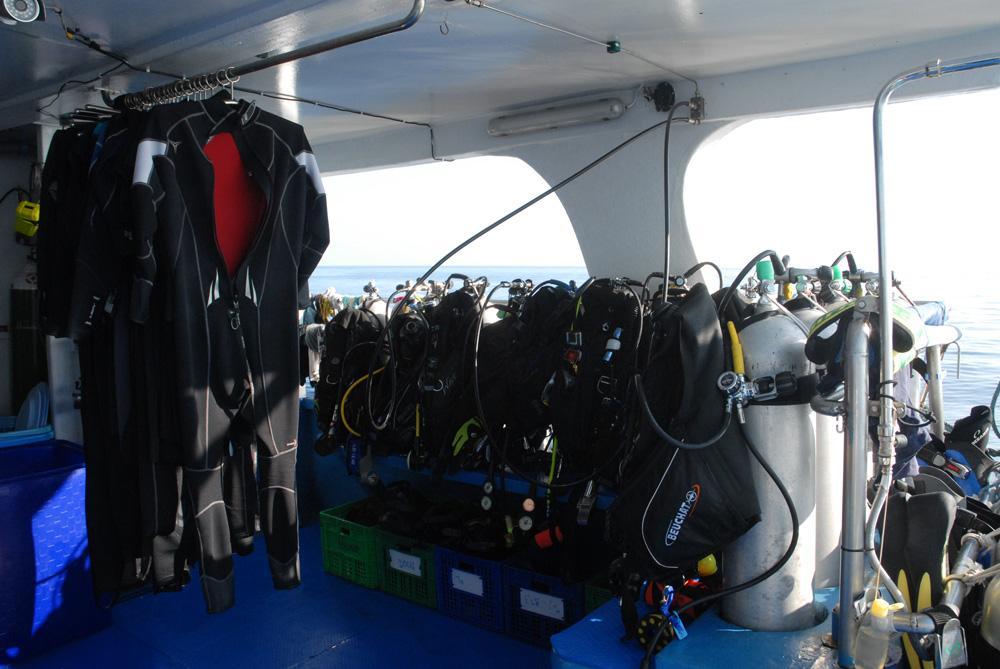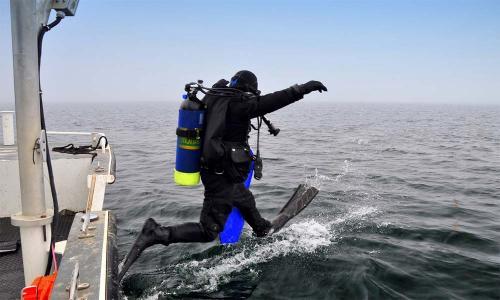 In addition to tanks and weights, there are five main items for scuba diving, of which four are necessary. These are BCD (buoyancy control device or STAB jacket), regulator, mask & fins. The fifth item is a wetsuit, although wetsuits are not as necessary in the tropically-warm seas of Thailand’s west coast. Without these items, scuba diving is almost impossible. You need to control your buoyancy, breathe, see, and manoeuvre around underwater. Staying warm is also necessary, but not vital. The tank and weights are of course vital, but always included in the diving fees, because they’re too heavy to travel with. So, what is a standard set of scuba diving equipment?
In addition to tanks and weights, there are five main items for scuba diving, of which four are necessary. These are BCD (buoyancy control device or STAB jacket), regulator, mask & fins. The fifth item is a wetsuit, although wetsuits are not as necessary in the tropically-warm seas of Thailand’s west coast. Without these items, scuba diving is almost impossible. You need to control your buoyancy, breathe, see, and manoeuvre around underwater. Staying warm is also necessary, but not vital. The tank and weights are of course vital, but always included in the diving fees, because they’re too heavy to travel with. So, what is a standard set of scuba diving equipment?
- The BCD is also referred to by some as a STAB. This is a jacket that the diver wears and the tank is attached to. The BCD’s main job is for the diver to partially inflate and deflate to ensure the perfect balance of buoyancy while under water. When at the surface at the end of the dive, the BCD is normally fully inflated to keep the diver floating until he or she is picked up by the team. If a dive centre charges a rental fee for a ‘full set’ of gear, the BCD is always included in this set.
- The regs are a set of hoses, mouthpieces and a gauge or two. These are connected to the tank & to the BCD, and the mouthpieces are obviously used for breathing through. Regs need care and maintenance more than other items in the set. If the dive centre charges for a ‘full set’ of gear, the regs are always included.
- The wetsuit is not something that everybody needs, but some people feel the cold even in warm water. The wetsuit does not keep you dry. Drysuits do that. Wetsuits allow you to get wet, but then they keep you warm by trapping the water inside and your body heat warms it to the same temperature as your body. In Thailand, 3mm shorty wetsuits are the normal items in a standard set of rental gear. A few dive centres have long-sleeve & long-leg wetsuits, but please do not expect it. It’s safe to expect a 3mm shorty and nothing else, unless you check with us first. Wetsuits are the third main large item that is always included in a ‘rental full set.’
- Masks (and snorkels) are small, and very personal to each person’s taste. Therefore, the mask is the most-common item that people have of their own to bring on a scuba diving trip in Thailand. Masks can be bought very cheaply if they’re basic items of low quality, but the price of a good diving mask can easily be more than $100. Dive centres always include a mask and usually include a snorkel in their ‘standard full set’ and these items are proper scuba diving masks that are not low quality cheap items. If you have your own mask, don’t expect any discount off of the ‘full set rate.’
- Finally, fins are always included in a standard full set of scuba diving equipment. Please be aware that for several reasons, the ‘rental’ fins are normally full-foot fins, meaning one piece that you squeeze your feet into. Very few dive centres in Thailand provide open-heel fins with booties as part of the standard rental items in a full set. The reasons for this are simple. The full-foot fins are cheaper to buy and almost impossible to damage. Open-heel fins have straps with plastic catches that can be broken if misused. And the booties can be lost. Dive centres with open-heel booty fins normally charge extra for these, even if there’s no charge for full-foot fins. However, one of our dive centres that runs Dolphin Queen supplies open-heel fins with booties free of charge. If you have your own fins, do not expect a discount from the ‘full set rate’ for rental gear.
- The tank is vital, and due to its size & weight, it’s always something that is provided by the dive centres. Even if you have your own full set of diving gear, a tank is provided at no extra charge. These are most-commonly 12-litre aluminium tanks with INT or DIN valves.
- Weights & a weightbelt are just like the tank. They are always provided at no charge. In particular, weights are by definition heavy and therefore it’s crazy to expect people to travel with them, especially on flights.
What other items are commonly asked for or charged for?
- The dive computer is something that is becoming more popular nowadays. Some of our divers have their own, and others want to rent or borrow one. Only divers on MV Andaman get a dive computer included in the standard rental set. Other dive centres usually charge 250-350 THB/day to rent a computer. The rental items are nearly always a basic dive computer that is worn on the wrist for diving but cannot be used as a watch to tell the time. Nowadays many new divers learn to dive using a computer, instead of manual tables of the past.
 A night-diving torch is vital for diving at night, and some diving liveaboards provide these for free. Others charge a small fee for using a torch for night dives. We feel that if the trip has a night dive, then the torch should be supplied for free, but we don’t make the rules. Some divers like to use a torch during the day to look in nooks & crannies.
A night-diving torch is vital for diving at night, and some diving liveaboards provide these for free. Others charge a small fee for using a torch for night dives. We feel that if the trip has a night dive, then the torch should be supplied for free, but we don’t make the rules. Some divers like to use a torch during the day to look in nooks & crannies.- Larger tanks, such as 15-litre tanks are sometimes requested, and most dive centres have these available and charge a nominal daily rate. The larger tank contains more air and therefore gives the diver more time underwater. To be honest, most experienced divers should be able to last an hour underwater on a 12-litre tank if they’re not going deeper than 30 metres. 60 minutes & 30 metres are the time & depth limits for all our Similan diving trips, so there should be no need for a larger tank. However, some large men, inexperienced divers, and photographers like the confidence of a larger tank. Also, when diving on Nitrox you can stay deep for longer, so a large tank is very useful.
- The SMB (surface marker buoy) is also called a safety sausage. These are vital pieces of equipment for the end of your dive, when you want the team on the boat to see you, then come to pick you up. All of our Similan Islands diving liveaboards provide Divemaster guides, and every guest must stay with their guide. Even qualified professional divers need to stay with their designated guide for safety reasons. Therefore, the SMB isn’t required for diving guests. However, in an extreme situation when divers may become separated from the group then an SMB would be useful, especially in rough seas. However, for 99%+ of our guests’ dives at The Similans, all divers surface with their DM Guide and he or she will use an SMB to attract the attention of the boat.
Brands and Quality of Rental Diving Equipment
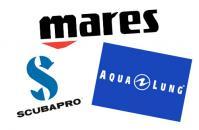 All of our dive centres who operate Similan liveaboard trips need to regularly maintain and replace equipment, as well as keep spares on the boat and back at the dive centre. The brands that they use depend on their own preferences, with AquaLung & ScubaPro being the most common. Mares equipment is available at some dive centres, but this is usually more expensive. Each brand has its own idea of which sizes should be S, M, L, XL etc. This applies to both wetsuits and BCDs. While some manufacturers may feel that a person who’s 1m 75cm tall & weighs 75kg should be regarded as ‘Medium’ others may consider this person to be ‘Large.’ Therefore don't worry if you don't know your BCD, Mask, wetsuit size etc before your trip. But it is important to enter your height, weight & Euro shoe size into your profile on our database, so that the dive centre can decide on the sizes. They know their own brands, and they’re experienced in choosing the correct sizes.
All of our dive centres who operate Similan liveaboard trips need to regularly maintain and replace equipment, as well as keep spares on the boat and back at the dive centre. The brands that they use depend on their own preferences, with AquaLung & ScubaPro being the most common. Mares equipment is available at some dive centres, but this is usually more expensive. Each brand has its own idea of which sizes should be S, M, L, XL etc. This applies to both wetsuits and BCDs. While some manufacturers may feel that a person who’s 1m 75cm tall & weighs 75kg should be regarded as ‘Medium’ others may consider this person to be ‘Large.’ Therefore don't worry if you don't know your BCD, Mask, wetsuit size etc before your trip. But it is important to enter your height, weight & Euro shoe size into your profile on our database, so that the dive centre can decide on the sizes. They know their own brands, and they’re experienced in choosing the correct sizes.
Scuba Diving Equipment Rates Vary
Each of our dive centres has their own idea of the rate for renting a full standard set of diving equipment, and one dive centre includes it for free but gives a 10% discount on the trip price if you bring your own. On average, a full standard set of diving equipment costs 500 THB/day to rent. Some dive centres charge less and others charge more. Also, each item varies in price. For example BCDs & regs are normally 200-300 THB/day, wetsuits are a little cheaper, & masks & fins are normally 0-150 THB/day. Please note that we do not control the pricing or brands of the equipment for the trips that we offer. Our customers deal directly with the boat or dive centre. In some cases, we need your sizes before you arrive, while in other cases you visit the dive centre to try the gear on. Each boat and dive centre has its own policy, procedure, needs & rates.

